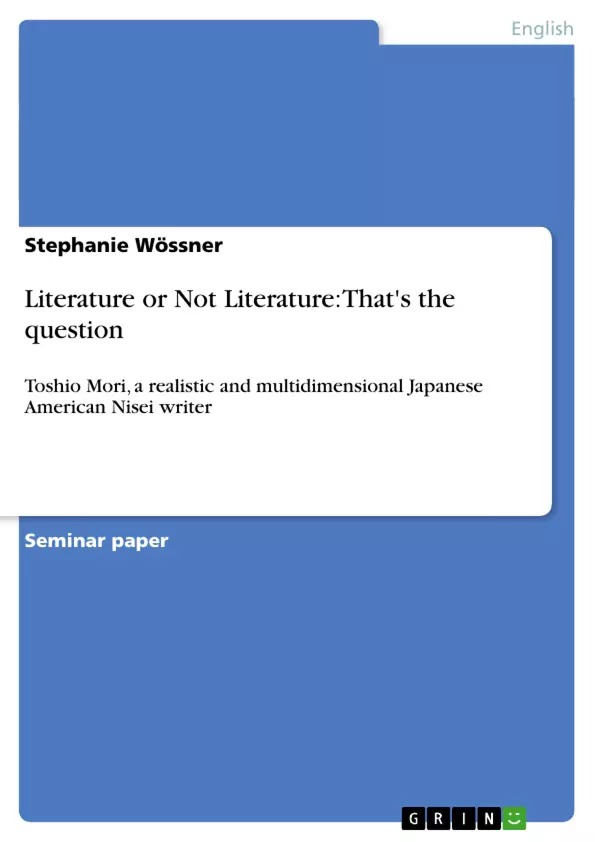What is Literature ? According to the American Heritage Dictionary of the English Language,
the term Literature is defined as
“Imaginative or creative writing, especially of recognized artistic value: “Literature must be
an analysis of experience and a synthesis of the findings into a unity” (Rebecca West).”
The Collins English Dictionary describes it as
“written material such as poetry, novels, essays, etc., esp. works of imagination
characterized by excellence of style and expression and by themes of general or
enduring interest.”
The emphasis in the first definition lies in the words “of recognized artistic value.” However,
in my opinion, what makes literature in the sense of “printed material” Literature is not
necessarily the recognition of its artistic value. As far as the second definition is concerned,
“by excellence of style and expression and by themes of general or enduring interest” seems
of primary importance. In opposition to this view, I believe that neither excellence of style
and expression nor themes of general interest are necessarily characteristic for what should
be considered Literature. In my understanding, everything that addresses our emotions, that
makes us feel for one moment with a situation described is of “artistic value,” and that things
that are not of general interest and may not excel in style and expression can still be equal
to the “Great Literature” recognized by the academic and literary world.
Critics have long considered Toshio Mori’s work
“overly sentimental and poorly plotted [… and] full of grammatical errors.” [...]
Inhaltsverzeichnis (Table of Contents)
- Introduction
- The Author's Life and Work
- Dimensions of Toshio Mori's Work
- Realism
- Historical
- Autobiographical
- Symbolic
- Universal
- Spiritual and Transcendental
- Artistic and Cultural
- Paradoxical
- Linguistic
- Pedagogical
- Political and Prophetic
- Conclusion
Zielsetzung und Themenschwerpunkte (Objectives and Key Themes)
This essay aims to explore the multifaceted work of Toshio Mori, a Japanese American Nisei writer whose writing has recently received recognition for its authentic portrayal of the Japanese American experience. The essay examines the various dimensions present in his stories, including realism, historical context, cultural influences, and his unique perspective on the Japanese American identity.
- The life and work of Toshio Mori as a Japanese American writer.
- The exploration of various dimensions present in his stories.
- The portrayal of Japanese American life and experiences during World War II.
- The impact of cultural influences and societal pressures on Japanese Americans.
- The search for identity within a dual cultural context.
Zusammenfassung der Kapitel (Chapter Summaries)
The first chapter introduces Toshio Mori and his work, discussing the recognition he has received in recent years for his realistic and multidimensional approach to depicting the Japanese American experience. The chapter also addresses conflicting views on what constitutes "literature" and argues that Mori's work possesses artistic value despite criticisms regarding its style and themes.
The second chapter focuses on Mori's life and influences, highlighting his upbringing in a Japanese American community and his unique blend of Japanese and American cultural influences. The chapter also sheds light on his experiences during World War II and his internment in a relocation camp.
The third chapter explores the various dimensions found in Mori's writing, including realism, historical context, autobiographical elements, symbolism, and universal themes. The chapter uses specific examples from Mori's stories to illustrate these dimensions, providing insights into his narrative style and his portrayal of Japanese American life.
Schlüsselwörter (Keywords)
This essay focuses on the Japanese American writer Toshio Mori, his multidimensional portrayal of Japanese American life, the impact of cultural influences, and the themes of identity, internment, and community. His works, such as "Yokohama, California" and "The Chauvinist and Other Stories," serve as valuable examples of literary realism and provide a unique perspective on the Japanese American experience.
- Citation du texte
- B.A. Stephanie Wössner (Auteur), 2003, Literature or Not Literature: That's the question , Munich, GRIN Verlag, https://www.grin.com/document/138132



